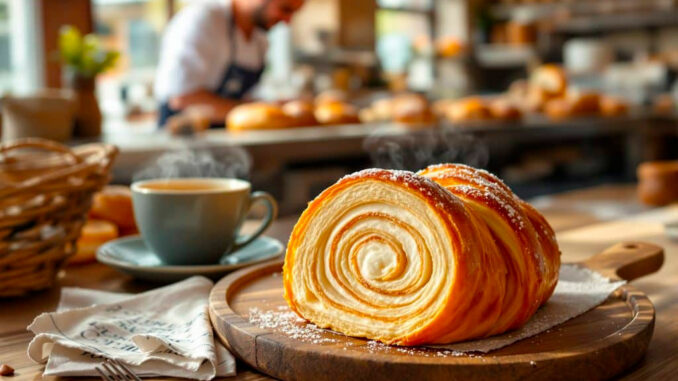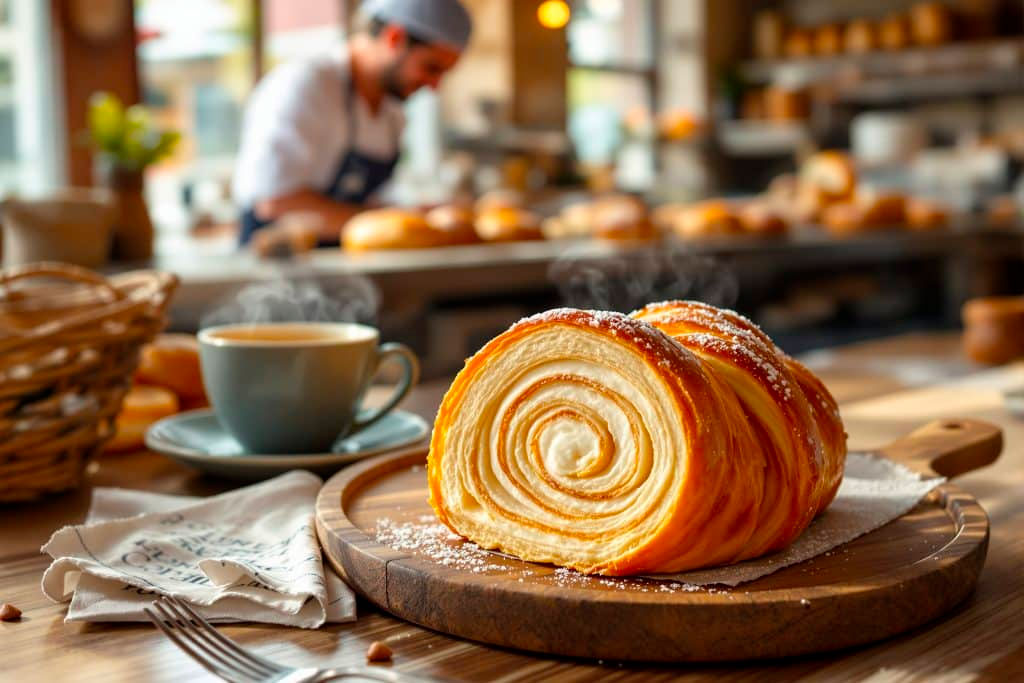
The Tourbillon Parisien blends croissant layers and brioche richness with a molten center. A 2025 pastry trend driving queues across Paris.
The Tourbillon Parisien, also called the Parisian Swirl, has become the new pastry trend shaping early-2025 food culture in Paris. It replaces the short-lived crookie craze and stands out for its technical complexity. Bakers combine a laminated croissant-style dough with a richer brioche base to create a spiral structure that remains crisp on the outside and soft within. Most versions include a melting center of praline, pistachio, or chocolate, which has made the pastry ideal for social-media videos. Bakeries such as Maison Sireix have seen long lines form as soon as they open, and TikTok and Instagram are saturated with clips of customers breaking the swirl in half to reveal the molten interior. This article explains what the Tourbillon Parisien is, why it is trending, how it is made, where it can be found, and what the rise of this pastry reveals about innovation in contemporary French baking.
The rise of the Tourbillon Parisien in the 2025 pastry landscape
The context behind the new Parisian craze
The Tourbillon Parisien emerged at a time when hybrid pastries have become an essential part of contemporary bakery culture. After a period dominated by the crookie—an oversized croissant filled with cookie dough—bakers and customers have shown interest in creations that offer more precision and less shock value. The Tourbillon Parisien fits that profile. It appeals to customers seeking a pastry that is visually attractive, structurally complex, and rooted in French baking expertise rather than pure novelty.
Social media has dramatically accelerated its rise. Short videos of the pastry cracking open and revealing a flowing center now circulate daily on food accounts. The visual effect plays a decisive role. The swirl shape, combined with the molten heart, produces a clean and satisfying reveal. For this reason, influencers have repeatedly selected the Tourbillon Parisien as a “must-film” item, giving it the kind of exposure that pushes customers directly into bakeries.
The reasons behind its sudden popularity
Several factors explain why the Tourbillon Parisien has replaced the crookie as the pastry of the moment. First, the texture contrast is stronger and more refined. The outside remains crisp, the inside stays soft, and the center melts as soon as pressure is applied. This triple texture profile is rarely achieved in standard viennoiseries. Second, the swirl shape makes the pastry instantly identifiable. Even without a label, customers can immediately recognise the product.
Third, the association with reputable bakers has shaped public perception. When viennoiseries begin trending because of fast-food appeal, interest fades quickly. Here, the conversation centres on skill, shaping technique and controlled baking. That gives the Tourbillon Parisien more credibility and signals that the trend may last longer than earlier viral pastries.
The technical composition of the Tourbillon Parisien
The dough behind the swirl
The foundation of the Tourbillon Parisien lies in a precise combination of croissant dough and enriched brioche dough. Bakers start with a base rich in butter and eggs but laminate it as they would for a croissant. This creates alternating layers that expand during baking and deliver a crisp exterior. The rolled structure forms a spiral roughly twelve to fourteen centimetres (about five to five-and-a-half inches) in diameter.
The dough must remain cold during lamination to prevent butter from melting. Bakers commonly chill the dough between folds and allow an extended final proofing phase at low temperature. This step improves flavour development and ensures a uniform rise during baking.
The molten heart and flavour variations
One of the defining features of the Tourbillon Parisien is its molten centre. Most versions contain pistachio paste, hazelnut praline, chocolate ganache or a caramel-based filling. The filling must withstand high oven temperatures while remaining fluid after cooling. Bakers adjust water content, fat levels and emulsifiers to maintain this consistency.
The molten heart usually weighs between twenty and thirty grams (about one ounce), enough to create a flowing effect without weakening the structure. The filling is either injected after shaping or inserted during assembly before the final spiral is rolled.
Surface finishing varies from shop to shop. Some bakers dust powdered sugar on top, while others add ground pistachio or a thin glaze to enhance sheen and flavour. The goal is to maintain a clean look that reinforces the swirl effect.
The shaping and baking process
Shaping the Tourbillon Parisien requires more time than shaping a croissant. The dough is rolled out into a long rectangle, filled, and then coiled into a tight spiral. This spiral must be symmetrical to ensure even baking. If the coil is too loose, the pastry loses its visual identity. If too tight, the dough may compress and prevent proper rise.
The baking temperature often ranges between one hundred eighty and one hundred ninety degrees Celsius (around three hundred fifty-six to three hundred seventy-four degrees Fahrenheit). Bakers frequently inject steam during the first minutes of baking to support lamination and produce a crisp exterior.
The final product weighs roughly one hundred twenty to one hundred fifty grams (four to five ounces), slightly heavier than a standard croissant.
The places shaping the trend
The Paris bakeries driving the movement
Although several bakeries now produce their own version, Maison Sireix is widely credited with popularising the Tourbillon Parisien. Photos of queues outside the shop circulate daily, and customers often arrive early to secure a box before they sell out. The pastry’s limited daily production has intensified demand and contributed to its reputation as a sought-after item.
Other Parisian bakeries have responded by developing their own interpretation. Some offer pistachio-heavy versions, others favour intense dark-chocolate fillings. A few shops outside Paris have started producing the pastry as well, though typically in small batches to test customer interest before committing to daily production.
The influence of social media platforms
TikTok and Instagram play a central role in the trend. Videos show the swirl breaking open and the molten filling stretching downward. In one clip, a pistachio version produced more than a million views in less than a day. Food influencers describe the pastry as a “must-try in Paris”, often ranking it alongside well-established viennoiseries such as the pain au chocolat or the almond croissant.
This constant visibility creates strong demand. Some bakeries report waiting times of ten to twenty minutes on weekend mornings, even before doors officially open. The scarcity factor reinforces the desire to obtain the pastry and fuels additional content creation.
The economic impact and pricing strategy
The Tourbillon Parisien is priced above traditional viennoiseries. Many shops sell it between four and five euros (about three pounds forty to four pounds twenty or four dollars sixty to five dollars sixty), depending on the filling and size. The higher price reflects the labour-intensive process and the quantity of premium ingredients.
For bakeries, it serves as a profitable item that increases average customer spending. For consumers, the price contributes to the perception that the Tourbillon Parisien is a premium product rather than an everyday purchase.
The deeper meaning of the Tourbillon trend
The strengths that drive the movement forward
The Tourbillon Parisien succeeds because it combines technical skill, recognisable shape and sensory appeal. It proves that French bakeries can innovate without abandoning craftsmanship. The product also demonstrates how social media now influences bakery innovation just as much as culinary tradition does.
The challenges that could slow its expansion
Despite its success, several constraints remain. Reproducing the molten centre consistently is difficult. If the filling crystallises too quickly or leaks during baking, the pastry loses its appeal. Some bakeries may rush production to meet demand, which can lead to uneven results. There is also the risk of oversaturation if every shop releases its own version too quickly.
The long-term outlook for this pastry
Whether the Tourbillon Parisien becomes a permanent fixture of French bakeries or simply a major trend of early-2025 remains uncertain. What is clear, however, is that it reflects the evolution of urban bakery culture: customers seek flavour, craftsmanship and shareable moments. The Tourbillon Parisien delivers all three, making it a significant case study for anyone interested in baking trends in France.
The Tourbillon Parisien stands at the crossroads of technique, texture and digital visibility. Its rise shows how a pastry can shape public attention through craftsmanship as much as through its visual impact. For anyone observing the dynamics of French viennoiserie, the swirl offers valuable insight into where innovation comes from, how trends form, and how quickly they reshape the bakery landscape in Paris.
Cook in France is your independant source for food in France.
